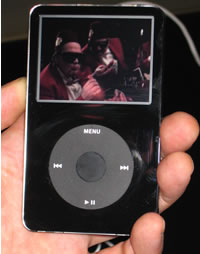 Apple have just announced that they have signed deals with six major airlines, offering the first seamless integration between iPod and the planes in-flight entertainment systems.
Apple have just announced that they have signed deals with six major airlines, offering the first seamless integration between iPod and the planes in-flight entertainment systems.
Starting mid 2007, Air France, Continental, Delta, Emirates, KLM and United passengers will be able to charge their iPod while in the air, but more interestingly be able to watch the video held on their iPods on the seat-back monitor.
Beyond that, Panasonic Avionics Corporation is working with Apple to build it into other airlines
Comment
This is a great deal for Apple. Not only do they fix the problem with people running their batteries down during a flight, and possibly not having any juice when they land and continue their journey, but as they’ve got first mover advantage on this. It’s going to be significantly harder for another player to have their kit integrated in to the planes. There’s only so many connectors that the airlines can make available.
We asked Apple if it was an exclusive deal, thereby blocking out other media players, but at the time of going to press we hadn’t heard back.
For the passenger, surely the wise move would be just to provide a USB port and allow people to plug whichever device they have with them, and have the in-flight system decode the media file and play them back. Thereby not being locked to a make of player.
The only down side we can see for this is for the airlines, as they won’t be making money out of charging for films.
 If you’ve admired the look of that bloke in Star Trek with the funky sci-fi specs, then maybe the Eye-Theatre glasses might be just the thing for you.
If you’ve admired the look of that bloke in Star Trek with the funky sci-fi specs, then maybe the Eye-Theatre glasses might be just the thing for you.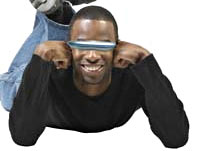 Weighing just 78g, the Eye-Theatre should be good for eight hours between charges (USB charger supplied), and anyone desperate to get that cyber-berk look can pre-order their video glasses from PDT’s website for £149.99, with the launch expected in mid-October.
Weighing just 78g, the Eye-Theatre should be good for eight hours between charges (USB charger supplied), and anyone desperate to get that cyber-berk look can pre-order their video glasses from PDT’s website for £149.99, with the launch expected in mid-October. Samsung is getting ready to unveil what it reckons is the first 70in HD (high-definition) LCD (liquid crystal display) panel.
Samsung is getting ready to unveil what it reckons is the first 70in HD (high-definition) LCD (liquid crystal display) panel.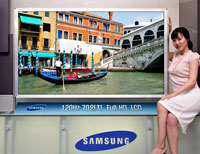 Executive Vice President Kim Sang-Soo of Samsung Electronics was ready to parp his company’s PR trumpet: “Our new 70-inch LCD is not only significantly larger, but also sets a new benchmark of excellence in terms of video image reproduction, viewing angle and image quality. We’ve designed it to dramatically enhance the large screen LCD TV user’s viewing experience. ”
Executive Vice President Kim Sang-Soo of Samsung Electronics was ready to parp his company’s PR trumpet: “Our new 70-inch LCD is not only significantly larger, but also sets a new benchmark of excellence in terms of video image reproduction, viewing angle and image quality. We’ve designed it to dramatically enhance the large screen LCD TV user’s viewing experience. ” Following the long tradition of Web innovations often premiering in the
Following the long tradition of Web innovations often premiering in the  Introduced earlier this year, the 3D displays have been used for professional applications, but the Holland Casino will be the first company in the leisure and entertainment world in Europe to use these 3D displays for the general public.
Introduced earlier this year, the 3D displays have been used for professional applications, but the Holland Casino will be the first company in the leisure and entertainment world in Europe to use these 3D displays for the general public. The Holland Casino plans to integrate the 3D screens in a new national jackpot concept, the Mega Million Jackpot, with the technology being introduced in the Autumn.
The Holland Casino plans to integrate the 3D screens in a new national jackpot concept, the Mega Million Jackpot, with the technology being introduced in the Autumn. Korean technology company Daewoo Lucoms, have unveiled their new ultra mobile PC Solo M1.
Korean technology company Daewoo Lucoms, have unveiled their new ultra mobile PC Solo M1. The Solo M1 features a variety of multimedia features, including video and music playback via Windows Media player, a DMB tuner, a 1.3 MP webcam for video conferencing and a 4-in-1 (MMC/ SDIO/ MS/ MS Pro) memory card reader.
The Solo M1 features a variety of multimedia features, including video and music playback via Windows Media player, a DMB tuner, a 1.3 MP webcam for video conferencing and a 4-in-1 (MMC/ SDIO/ MS/ MS Pro) memory card reader.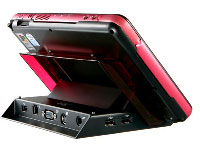 There’s also a range of optional accessories available, including a leather case, mini keyboard and external optical drive.
There’s also a range of optional accessories available, including a leather case, mini keyboard and external optical drive.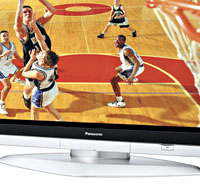 People still waiting for those wall-sized flat screen TVs that were promised in sci-fi books will be able to take a step closer to their dream with the announcement of Matsushita’s thumping great 103-inch panel TV.
People still waiting for those wall-sized flat screen TVs that were promised in sci-fi books will be able to take a step closer to their dream with the announcement of Matsushita’s thumping great 103-inch panel TV. The specifications look sumptuous though, with the 103-inch panel offering a full 1080i HD resolution (1,920 by 1,080 pixels) and an “aaaieee – my eyes!” brightness rating of 3000:1.
The specifications look sumptuous though, with the 103-inch panel offering a full 1080i HD resolution (1,920 by 1,080 pixels) and an “aaaieee – my eyes!” brightness rating of 3000:1.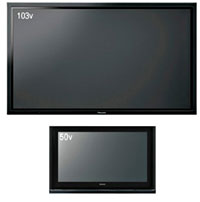 Panasonic reckon that they’ll be able to shift around 5,000 of these enormo-displays in the first year, although they added that probably only 20% of takers will be TV viewers, with the majority buying the display for use as electronic billboards, or displays in studios and corporate lobbies.
Panasonic reckon that they’ll be able to shift around 5,000 of these enormo-displays in the first year, although they added that probably only 20% of takers will be TV viewers, with the majority buying the display for use as electronic billboards, or displays in studios and corporate lobbies. Smaller than a pack of cards and packed with enough whizz-bang functionality to keep a hyperactive cokehead entertained for hours, MobiBox’s new MP410 multimedia recorder and player packs a big punch for the price.
Smaller than a pack of cards and packed with enough whizz-bang functionality to keep a hyperactive cokehead entertained for hours, MobiBox’s new MP410 multimedia recorder and player packs a big punch for the price.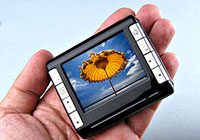 The MP410 also features a pair of folding out speakers for added ‘Tony Blair’ appeal, and comes with a pull-out stand for desk viewing.
The MP410 also features a pair of folding out speakers for added ‘Tony Blair’ appeal, and comes with a pull-out stand for desk viewing. Interface 2 in 1 MiniUSB (USB 2.0/power in)
Interface 2 in 1 MiniUSB (USB 2.0/power in) LG Electronics has rolled up its beefy sleeves, raised its fists and shouted, “Come oooonnn!!!! Let’s be ‘aving you!” to the electronics world, declaring its intent to more than double its share of the world’s top products by 2010.
LG Electronics has rolled up its beefy sleeves, raised its fists and shouted, “Come oooonnn!!!! Let’s be ‘aving you!” to the electronics world, declaring its intent to more than double its share of the world’s top products by 2010. With a direct hit on the spittoon, he continued, “By substantially increasing the number of flagship goods through our technological prowess, we aim to evolve into a bona fide powerhouse.’
With a direct hit on the spittoon, he continued, “By substantially increasing the number of flagship goods through our technological prowess, we aim to evolve into a bona fide powerhouse.’ Pointing aggressively, Myung-wo says he wants the global market for plasma display panel (PDP) modules, PDP TVs, liquid crystal display (LCD) TVs, side-by-side refrigerators, built-in air conditioners and drum washers to be pwned by LG.
Pointing aggressively, Myung-wo says he wants the global market for plasma display panel (PDP) modules, PDP TVs, liquid crystal display (LCD) TVs, side-by-side refrigerators, built-in air conditioners and drum washers to be pwned by LG.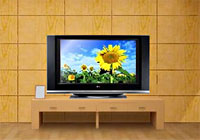 Similarly, when it comes to domestic air conditioners, LG rules the roost, and the company is now wrestling for the crown of King of Flat-Panel Displays, knocking out 730,000 plasma units last year to nudge past market leaders Samsung SDI.
Similarly, when it comes to domestic air conditioners, LG rules the roost, and the company is now wrestling for the crown of King of Flat-Panel Displays, knocking out 730,000 plasma units last year to nudge past market leaders Samsung SDI. LG has announced their new multimedia-tastic 12-inch notebook PC, the LW25 EXPRESS DUAL, which is, apparently, “a portable multimedia powerhouse.”
LG has announced their new multimedia-tastic 12-inch notebook PC, the LW25 EXPRESS DUAL, which is, apparently, “a portable multimedia powerhouse.” The built in optical drive (or Super Multi ODD as LG likes to call it) supports playback and recording of all existing optical media formats inluding dual-layer DVD burning, allowing you to cram up to 8.5GB data on a single DVD.
The built in optical drive (or Super Multi ODD as LG likes to call it) supports playback and recording of all existing optical media formats inluding dual-layer DVD burning, allowing you to cram up to 8.5GB data on a single DVD.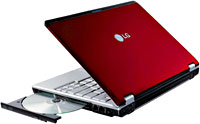 As for pricing and availability, your guess is as good as ours at the moment as LG seem to be keeping mum.
As for pricing and availability, your guess is as good as ours at the moment as LG seem to be keeping mum. Mobile phone companies have been striving to develop high resolution displays to capitalise on the potential of multi-media content. This week, Samsung joined the growing list of manufacturers who have created a true VGA display suitable for mobile phones.
Mobile phone companies have been striving to develop high resolution displays to capitalise on the potential of multi-media content. This week, Samsung joined the growing list of manufacturers who have created a true VGA display suitable for mobile phones. VGA has been available on handheld devices for a while now. Toshiba debuted the first PDA with VGA display (the e805) back in December 2003 and the first VGA mobile, Sharp’s 904SH, launched in Japan in April this year. The latter has four times the resolution of the average QVGA (Quarter VGA) display and face recognition functions that authenticates users by their facial features.
VGA has been available on handheld devices for a while now. Toshiba debuted the first PDA with VGA display (the e805) back in December 2003 and the first VGA mobile, Sharp’s 904SH, launched in Japan in April this year. The latter has four times the resolution of the average QVGA (Quarter VGA) display and face recognition functions that authenticates users by their facial features.